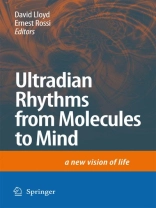5. 1. 1 Biological Rhythms and Clocks From an evolutionary perspective, the adaptation of an organism’s behavior to its environment has depended on one of life’s fundamental traits: biological rhythm generation. In virtually all light-sensitive organisms from cyanobacteria to humans, biological clocks adapt cyclic physiology to geophysical time with time-keeping properties in the circadian (24 h), ultradian (24 h) domains (Edmunds, 1988; Lloyd, 1998; Lloyd et al. , 2001; Lloyd and Murray, 2006; Lloyd, 2007; Pittendrigh, 1993; Sweeney and Hastings, 1960) By definition, all rhythms exhibit regular periodicities since they constitute a mechanism of timing. Timing exerted by oscillatory mechanisms are found throughout the biological world and their periods span a wide range from milliseconds, as in the action potential of n- rons and the myocytes, to the slow evolutionary changes that require thousands of generations. In this context, to understand the synchronization of a population of coupled oscillators is an important problem for the dynamics of physiology in living systems (Aon et al. , 2007a, b; Kuramoto, 1984; Strogatz, 2003; Winfree, 1967). Circadian rhythms, the most intensively studied, are devoted to measuring daily 24 h cycles. A variety of physiological processes in a wide range of eukaryotic organisms display circadian rhythmicity which is characterized by the following major properties (Anderson et al. , 1985; Edmunds, 1988): (i) stable, autonomous (self-sustaining) oscillations having a free-running period under constant envir- mental conditions of ca.
Table des matières
The Molecular-Genetic-Cellular Level.- The Ultradian Clock (~40 min) in Yeast (Saccharomyces cerevisiae).- ENOX Proteins, Copper Hexahydrate-Based Ultradian Oscillators of the Cells’ Biological Clock.- Self-Organized Intracellular Ultradian Rhythms Provide Direct Cell-Cell Communication.- Phosphorylation Dynamics in Mammalian Cells.- Is There a Mitochondrial Clock?.- Invertebrate Systems.- Ultradian and Circadian Rhythms: Experiments and Models.- Ultradian Lovesong Rhythms in Drosophila.- Mid-range Ultradian Rhythms in Drosophila and the Circadian Clock Problem.- Tidal Rhythms.- The Neuroendocrineal and Developmental Level.- Pulsatile Hormone Secretion: Mechanisms, Significance and Evaluation.- Ultradian Rhythms as the Dynamic Signature of Life.- The Mammalian Circadian Timekeeping System.- Ultradian and Circadian Rhythms in Human Experience.- Ultradian Cognitive Performance Rhythms During Sleep Deprivation.- High Frequency EEG and Its Relationship to Cognitive Function.- Total Sleep Deprivation and Cognitive Performance: The Case for Multiple Sources of Variance.- Open Questions on Mind, Genes, Consciousness, and Behavior: The Circadian and Ultradian Rhythms of Art, Beauty, and Truth in Creativity.- Genes, Sleep and Dreams.- Epilogue: A New Vision of Life.
Langue Anglais ● Format PDF ● Pages 450 ● ISBN 9781402083525 ● Taille du fichier 8.8 MB ● Éditeur David Lloyd & Ernest Rossi ● Maison d’édition Springer Netherland ● Lieu Dordrecht ● Pays NL ● Publié 2008 ● Téléchargeable 24 mois ● Devise EUR ● ID 2148704 ● Protection contre la copie DRM sociale












